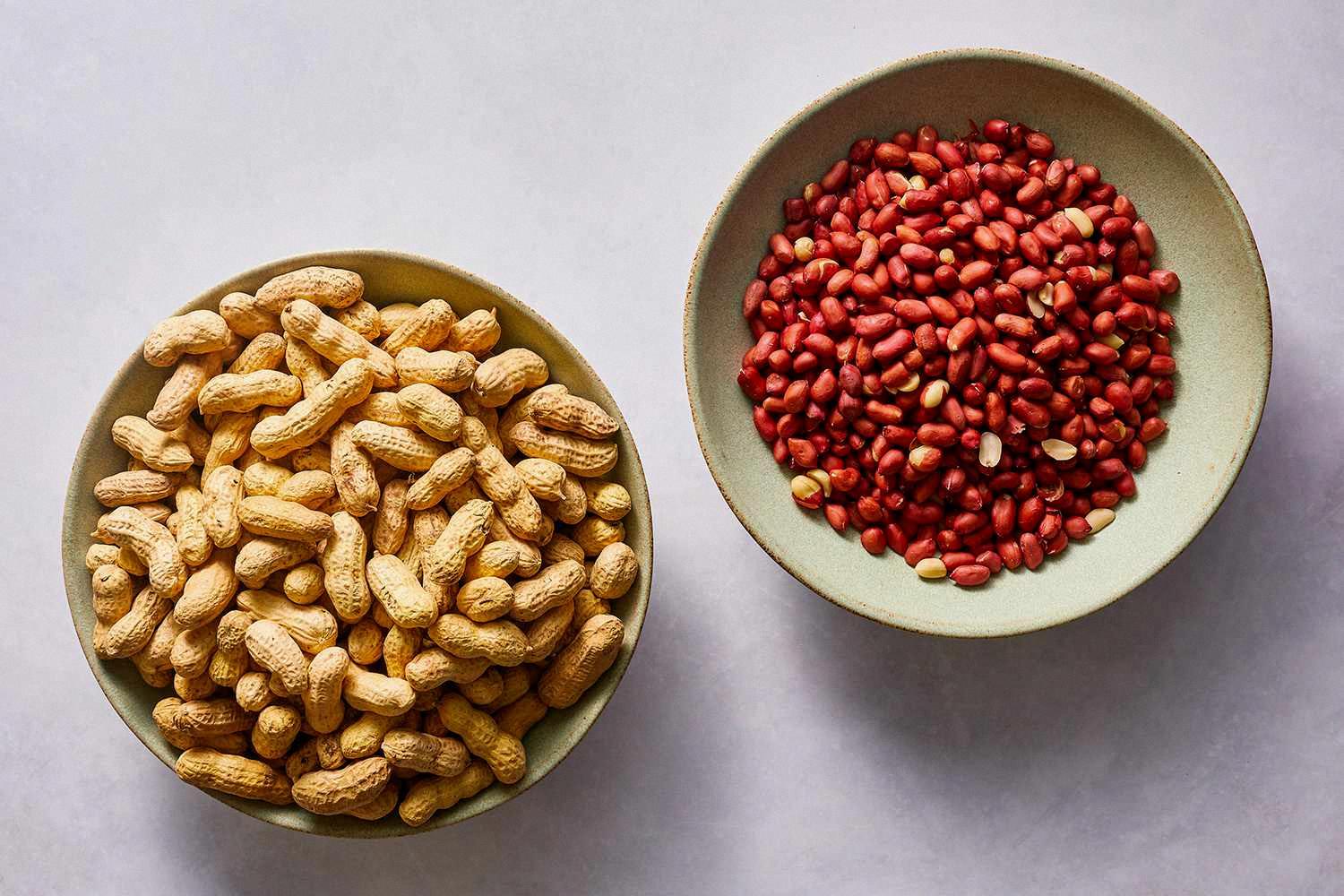If you’ve ever wondered where peanuts come from, you may be surprised to learn that they actually grow underground! Unlike most plants, the peanut plant flowers above ground, but fruits below ground. From planting to harvesting, the growing cycle of a peanut takes 4 to 5 months, depending on the type and variety.
But why do peanuts grow underground? The answer lies in the fact that peanuts are not actually nuts at all, but rather legumes. Legumes such as peanuts, numerous types of beans, and chickpeas produce fruit in the form of seed pods. These pods grow underground, where the soil provides a warm and protected environment for the developing peanuts.
The peanut plant begins as a small, green shoot, which eventually grows into a leafy plant that can reach up to 18 inches in height. As the plant grows, it produces small, yellow flowers that eventually give way to the peanut pods. The pods, which can range in size from a marble to a golf ball, contain anywhere from one to four peanuts each.
Harvesting peanuts is a labor-intensive process that typically involves digging up the entire plant and then shaking off the dirt to reveal the peanut pods. The pods are then separated from the plant and allowed to dry before the peanuts are removed.
While peanuts may not grow on trees like othr nuts, they are still a valuable crop that is widely consumed around the world. In fact, peanuts are one of the most widely grown crops in the United States, with over 1 million acres of farmland dedicated to their production.
So the next time you enjoy a handful of roasted peanuts or a jar of peanut butter, remember that these tasty treats come from humble beginnings underground.
Are Peanuts Grown Above or Below Ground?
Peanuts are a unique plant in that they flower above the ground but actually fruit below ground. The peanut plant grows from a seed and can take around 4 to 5 months to fully mature, depending on the specific type and variety being grown. During this time, the plant develops both above and below ground structures. The flowers of the peanut plant develop above ground and resemble small yellow flowers. However, once the flowers have been pollinated, the plant begins to produce fruit, wich grows below ground. These fruits, or peanuts, grow in a pod that emerges from the base of the flower and penetrates the soil. As the peanuts grow, they continue to develop underground until they are ready for harvesting. Overall, the unique growth cycle of the peanut plant is what makes it such an intriguing crop to cultivate.

Are Underground-Growing Nuts Limited to Peanuts?
No, peanuts are not the only nuts that grow underground. In fact, peanuts are not even nuts, they belong to the legume family. However, there are some true nuts that do grow underground, such as the earthnut, also known as the groundnut or the monkey nut. The earthnut is a type of nut that grows underground and is similar in taste and appearance to peanuts. Other examples of nuts that grow underground include the wild nut, the hog peanut, and the buffalo nut. However, the majority of nuts, such as almonds, cashews, and walnuts, grow on trees.
The Benefits of Growing Peanuts Underground
Peanuts grow underground because they belong to the legume family, which includes plants that produce fruit in the form of seed pods. Unlike other nuts, such as almonds or walnuts, which grow on trees, peanuts grow on small bushes that thrive in warm climates. After the peanut plant completes its flowering stage, the stem of the plant elongates and bends towards the ground. The tip of the stem then penetrates the soil, where the peanut pods start to develop. As the pods mature, they grow underground and eventually reach a size where they can be harvested. It is worth noting that peanuts are not atually nuts, but are classified as legumes due to their seed pod production. In summary, the reason why peanuts grow underground is due to their unique growth pattern as a legume plant.
Types of Nuts That Grow Underground
Although commonly referred to as nuts, only one type of nut actually grows underground, and that’s the peanut. Peanuts, also known as groundnuts, are part of the legume family and grow beneath the soil surface. They are unique in comparison to other nuts like almonds, walnuts, pecans, and hazelnuts, which all grow on trees. Interestingly, other legumes such as soybeans, chickpeas, and lentils also grow underground, but they are not considered nuts.
The Difference Between Tree Nuts and Peanuts
The primary difference between tree nuts and peanuts is their origin and botanical classification. Peanuts are legumes that grow underground and belong to the same family as beans and peas, while tree nuts are produced on trees and include a variety of nuts like almonds, walnuts, cashews, and pecans. Legumes are edible seeds enclosed in pods, while nuts are essentially the fruit of a tree, protected by a hard outer shell that contais the seed. Additionally, peanuts have a distinct nutritional profile, containing more protein and fiber than most tree nuts. Meanwhile, tree nuts are rich in healthy fats, vitamins, and minerals, making them an excellent source of nutrition. Overall, while peanuts are considered a type of nut in culinary settings, they differ significantly from tree nuts in terms of their botanical classification, growing conditions, and nutritional content.

The Legality of Growing Peanuts
In the United States, it is not illegal to grow peanuts for personal consumption in a home garden. However, commercial growers in some states, such as Georgia or Virginia, are required to have a license and follow specific regulations when purchasing and selling their seeds. It is important to check your state’s laws and regulations before embarking on any commercial peanut growing endeavors to ensure compliance with the law. Overall, growing peanuts for personal consumption is legal and can be a fun and rewarding hobby.
Can You Eat Raw Peanuts Directly From the Ground?
It is not recommended to eat raw peanuts that have been freshly dug from the ground. These peanuts, also kown as green peanuts, have a very high moisture content and can contain harmful bacteria that can cause illness if consumed. In addition, raw peanuts contain anti-nutrients such as phytic acid, which can interfere with the absorption of important minerals in the body. Therefore, it is recommended to cook raw peanuts before consumption to reduce the risk of illness and to increase their nutritional value. Proper cooking methods can help to remove harmful bacteria and reduce the levels of anti-nutrients, making them safe and healthy to eat.
Why Cashews Are Not Considered Nuts
Despite beig commonly referred to as a nut, a cashew is not actually a nut. Rather, it is a type of drupe. A drupe is a fruit that has a fleshy exterior and a hard shell covering a seed on the inside. In the case of a cashew, the fleshy part is the edible fruit stalk, which is known as the cashew apple, while the hard shell contains the seed, or the cashew nut. The shell of the cashew nut is toxic and must be removed before consumption. Therefore, while cashews may resemble nuts in appearance and taste, they are actually a type of fruit, specifically a drupe.
Can Raw Peanuts Be Grown?
Yes, you can grow a raw peanut. To do so, you will need to break open a raw peanut shell to expose the seeds. Plant the seeds at least 2 inches into the soil, ensuring that the soil is well-drained and has good fertility. Water the plant once a week, making sure not to over-water it. As the plant grows, it will produce a yellow flower after 30-40 days. At this point, you will need to mound soil aroud the base of the plant so that the peanut ‘pegs’ can push into the soil. With the right care and attention, you can successfully grow your own raw peanuts at home.

Source: nytimes.com
The Unique Plant That Grows Its Fruits Underground
The only plant that grows its fruits underground is the peanut, scientifically known as Arachis hypogaea. This plant belongs to the legume family and is native to South America. The peanut plant produces yellow flowers that after pollination, grow downwards towards the ground, whre they will eventually develop into peanut pods. The pods mature underground, and when ready, they are harvested by digging them up from the soil. The peanut is an excellent example of geocarpy, which is the production of fruits underground. Other plants like arum lilies (Stylochiton and Biarum) also produce fruits underground, but their flowers are already subterranean. Geocarpy is a unique adaptation to ensure the survival of the species, especially in harsh environments where above-ground fruits are vulnerable to predators or harsh weather conditions.
Where Do Peanuts Grow Naturally?
Peanuts are native to South America, specifically to the regions of Brazil, Peru, and Paraguay. However, today they are grown in many warm climate regions around the world, including Asia, Africa, Australia, and both North and South America. These regions provide the ideal growing conditions for peanuts, such as sandy soil, warm temperatures, and plenty of sunshine. In fact, the largest peanut-producing countries today include China, India, Nigeria, the United States, and Sudan. It’s worth noting that while peanuts don’t grow naturally everywhere, they are a widely cultivated crop that can thrive in many different environments with the rigt care and conditions.
The Effect of Peanuts on Soil Replenishment
Yes, peanuts can replenish the soil. Peanuts are considered legumes, which have the unique ability to fix atmospheric nitrogen into the soil. This nitrogen fixation process can help to replenish the soil with important crop nutrients, such as nitrogen. Additionally, when peanut residue is incorporated into the soil, it decomposes faster than if it were left on the surface. This decomposition can also help to replenish the soil with organic matter and other important nutrients. Overall, peanuts can be a beneficial crop for soil health and fertility.
Do Cashews Grow Below the Surface?
No, cashews do not grow underground. Contrary to popular belief, cashews actually grow on trees that can reach up to 12 meters (40 feet) in height. The cashew nut itself is actually the seed of the cashew fruit, whih grows at the end of the cashew apple. The cashew apple is a pear-shaped fruit that is typically red or yellow in color and is not commonly consumed in most parts of the world. After the cashew apple is harvested, the cashew nut is removed from the top of the fruit and then undergoes a process of roasting and shelling before it is ready for consumption. So in summary, cashews do not grow underground, but rather on trees that produce cashew apples which contain the cashew nut.

Source: thespruceeats.com
Appearance of Ground Nuts
A groundnut, also known as a peanut, can vary in size from as small as a pine nut to as large as an avocado. They have a brown outer shell that encases a firm, white interior once peeled. The plant that produces groundnuts has pinnate compound leaves with five to seven leaflets. It is a vine-like plant that twines around other plants and shrubs in the forest. So if you were to come across a groundnut, you can expect to see a brown, nut-like shell that contains a white, firm interior when peeled.
Types of Nuts That Do Not Grow On Trees
Yes, there is a type of nut that does not grow on trees. Peanuts, also known as groundnuts, are actually legumes that grow underground. Unlike tree nuts, which grow on trees and are enclosed in a hard shell, peanuts are grown underground and have a soft outer shell. Other legumes that are commonly mistaken for nuts include soybeans and lentils. However, it is important to note that while peanuts are often grouped together with tree nuts in terms of allergic reactions, they are botanically different and may not necessarily cause the same allergic response.
Conclusion
In conclusion, it is clear that peanuts do indeed grow underground. This is due to the fact that peanuts are legumes, which produce fruit in the form of seed pods. Unlike most plants, the peanut plant flowers above the ground, but fruits below the surface. This unique process is known as geocarpy. While peanuts are botanically classified as legumes, they are considered a nut for culinary, research, and nutritional purposes. It is important to note that although peanuts grow underground, they are not tree nuts like walnuts or almonds. The growing cycle of a peanut takes 4 to 5 months, depending on the type and variety. Overall, understanding how peanuts grow and their unique characteristics can prvide valuable insight into the agricultural and nutritional aspects of this popular food.
